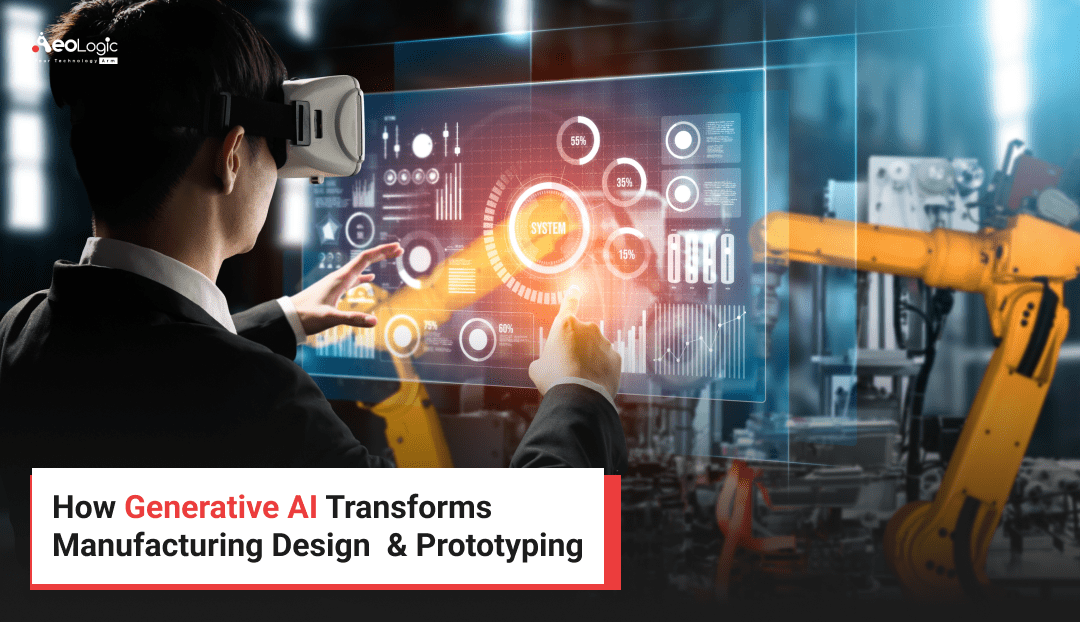A major shift is underway in how products are designed and built. What used to be slow, expensive, and limited by human imagination is now being accelerated and expanded through generative AI. Traditionally used in creative fields like art and writing, generative AI is now powering serious gains in manufacturing — particularly in design and prototyping. From the earliest sketches to physical models, manufacturers are seeing faster timelines, smarter outputs, and significant cost savings.
This blog explores how generative AI is transforming each stage of manufacturing design and prototyping, with examples, challenges, and a glimpse into the future.
What is Generative AI in Manufacturing?
Generative AI refers to algorithms that produce original outputs based on data and defined constraints. In manufacturing, that means generating design ideas, simulations, or complete prototypes automatically. Rather than manually specifying every detail in a CAD program, engineers can input high-level requirements — like weight, material type, or function — and let AI generate thousands of optimized designs.
This method contrasts with traditional CAD or rule-based design where engineers define shapes and rules step-by-step. Instead of rigid command sequences, generative AI works more like a design partner: iterating possibilities and refining outcomes at a speed no human team could match.
The Traditional Workflow
To appreciate how transformative this is, consider the typical manufacturing design workflow:
- Conceptualization – Engineers brainstorm and sketch ideas using CAD.
- Feasibility Review – Materials, stress factors, and production constraints are evaluated.
- Prototyping – Physical models are built, which can be costly and time-consuming.
- Testing and Iteration – Designs are tested, revised, and retested.
- Finalization – Once a viable prototype is approved, production begins.
Each of these phases is subject to delays, human bias, and repeated iterations. Generative AI disrupts this pattern by accelerating or even automating each step.
How Generative AI Transforms Each Stage
1. Accelerated Conceptual Design
Tools like Autodesk Fusion 360, Siemens NX, and nTopology allow engineers to input performance goals — such as durability, weight, or manufacturability — and generate a wide array of suitable designs in minutes.
Example: An automotive company designing a lightweight suspension component used generative AI to generate over 150 variations in a single session. Many options outperformed legacy designs, saving weeks of manual modeling.
2. Data-Driven Optimization
Generative AI thrives on data. It can analyze failure rates, product history, manufacturing tolerances, and cost data to refine designs further. Unlike traditional trial-and-error, this is outcome-first engineering.
Case Study: GM redesigned a seatbelt bracket with generative AI. The result was 40% lighter, 20% stronger, and required only one part instead of eight — reducing assembly time and cost.
3. Integration with Additive Manufacturing
AI-generated shapes often include complex curves and hollow structures that are ideal for 3D printing. This makes additive manufacturing the perfect partner for generative design.
Benefits:
- It speeds up prototype production.
- Designers can easily modify digital models.
- Material usage is minimized through optimized geometry.
As a result, AI doesn’t just accelerate iteration — it also unlocks new design possibilities.
4. Simulation & Virtual Testing
Before a prototype is ever printed, generative AI systems simulate stress, pressure, heat, and vibration. These simulations give engineers confidence in the design — reducing the need for costly physical iterations.
Example: Aerospace firms use generative AI to simulate extreme flight conditions. Virtual prototypes are tested under real-world stress without needing wind tunnels or multiple hardware builds.
5. Human-AI Collaboration
Generative AI isn’t here to replace engineers. It’s here to augment them. While AI handles repetitive computations and surface-level ideation, humans handle context, judgment, and final decisions.
This synergy encourages faster ideation, greater design diversity, and frees up time for strategic thinking. In turn, collaboration becomes more efficient and forward-thinking.
Key Benefits for Manufacturers
✅ Speed: What used to take weeks now happens in hours. Faster design = faster time to market.
✅ Cost Reduction: Fewer prototypes, smarter material use, and simplified assemblies all contribute to lower costs.
✅ Innovation: AI-generated designs often take unexpected forms, leading to breakthroughs human teams wouldn’t consider.
✅ Sustainability: Lightweight designs mean less material usage, lower emissions, and greener manufacturing.
✅ Accessibility: With intuitive interfaces, even junior engineers can produce expert-level designs.
Industry Applications
- Automotive: Enhancing performance while reducing vehicle weight.
- Aerospace: Creating ultra-light components for fuel efficiency.
- Medical Devices: Personalizing implants and braces via 3D scanning + AI.
- Architecture & Construction: Designing materials and structural elements that balance form, cost, and function.
Real-World Example: GM Seatbelt Bracket
Using Autodesk’s generative design tool, GM redesigned a seatbelt bracket that traditionally used eight parts. The AI-optimized version used only one. It was not only lighter and stronger but also easier to assemble, cutting down on both material waste and labor costs. This is a prime example of what’s possible when AI is given design authority under human supervision.
Challenges and Considerations
🔧 Workflow Integration: Traditional manufacturers may face issues integrating AI with existing CAD and ERP tools.
📉 Explainability: AI designs can be hard to interpret. Engineers may struggle to understand why a design looks the way it does — which can delay approval.
👷 Skill Gaps: AI literacy, simulation reading, and data interpretation are required. Training and upskilling are essential.
🔐 Intellectual Property: Legal clarity is still evolving. Who owns an AI-generated design?
💰 Upfront Investment: Generative AI platforms and training require capital, which may be challenging for small and medium-sized manufacturers.
The Future of Generative AI in Design
Generative AI is still maturing, but its trajectory is clear.
🌐 Cloud-Based CAD: Platforms like Onshape and Fusion 360 are moving to the cloud, enabling real-time collaboration and version control with AI enhancements.
🧠 Digital Twins: AI can continuously update digital twins of real-world products. Design changes are informed by real usage data.
🤝 Human-AI Teams: Engineers will collaborate with AI just like they do with other departments. It’s less about drawing and more about directing.
🎛 Hyper-Customization: AI enables mass-customized products—from orthopedic implants to bike frames—tailored to the individual without production delays.
Implementation Steps for Manufacturers
- Identify Use Cases: Start with small parts that would benefit from optimization.
- Explore Tools: Test platforms like Siemens NX, Fusion 360, or nTopology.
- Support Engineers: Offer AI, simulation, and additive manufacturing training.
- Pilot First: Run AI designs in limited environments to validate performance.
- Scale Strategically: Gradually incorporate AI across multiple stages of the design system.
Final Thoughts
Generative AI isn’t just helping manufacturers improve — it’s changing the game. By combining massive computing power with engineering logic, it enables teams to build faster, smarter, and more creatively.
From jet engines to medical implants, the future of manufacturing belongs to those who can think differently — and let AI help them do it.
For manufacturers, now is the time to experiment, pilot, and prepare. Because what’s cutting-edge today will be the baseline tomorrow.

Passionate about breaking down complex tech into simple ideas. Covers everything from AI and software development to gadgets and emerging tech trends.






